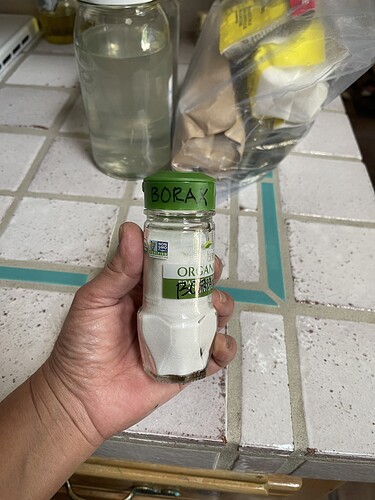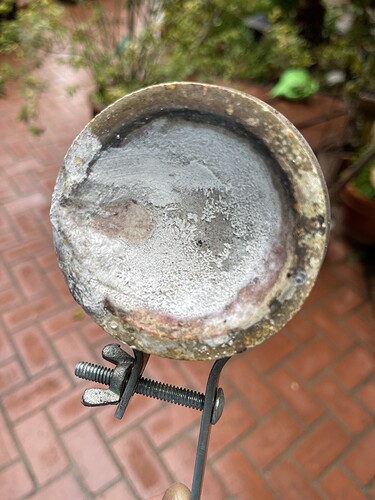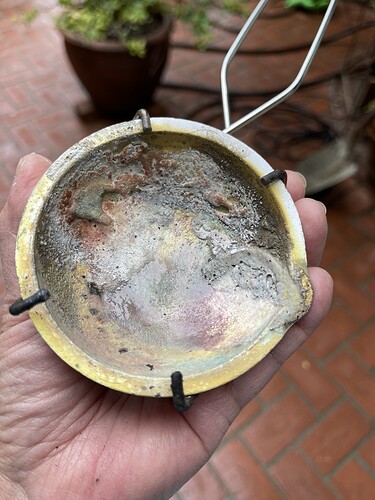Can anyone help me with the proper procedure for preparing a new
crucible for use with sterling silver and/ or gold? Can one be used
for both metals? Or is it better to keep them separate. I am new to
the forum and may have missed it if this has already been covered,
but I came up blank when I searched the database. Thanks in advance
Jim Malone
jm@dptmetalsmith.virtualave.net
Keep them separate! If you use one for gold, then use the same
one for silver, your silver will turn out yellow.
Make a paste using boric acid & water. Coat every part of the
inside. Place in a kiln -400 degrees or so, for 10-15 minutes.
Remove the crucible and let it cool.
I’d suggest separate crucibles each for silver, white gold, and
yellow gold. Heat them gradually , pointing a torch into the
bowl, till the inside surface is a nice cherry red. Sprinkle
borax (no 20 mule team, it has perfumes added) from a jewelry
tool supplier or chemical supply company. Keep sprinkling and
heating until it has a nice glassy coating inside. That’s it.
Hi, I would say that it is an absolute neccesity to have
different crucibles for each type of metal you cast as well as
each karat of gold and each type of sterling (standard Sterling
Alloy As well as Deox sterling alloys) Cross contamination will
cause problems and potentially lower the Karat content of your
gold .
Check out the casting pictures on my website under "workshop"
Dan http://www.racecarjewelry.comHi Jim, You didn’t specify if the crucible is for a centrifugal
casting machine or the hand held type. A method that works well
for me is to melt borax powder in the bottom of the crucible and
swirl or rotate the crucible around until the whole inside is
coated. Pour off any excess borax while keeping the torch on the
crucible. I use an oxidizing flame to actually “blow” the borax
out of the crucible. You don’t want any excess to get into the
casting. If using in a cent caster, load an empty flask in the
machine and spin the crucible while hot. Any excess borax will
be slung out of the crucible into the flask. I wouldn’t
recommend using the same crucible for both gold and silver, or
for different colors of gold. Ken
Jim: I would recommend boric acid powder, it goes liquid a
little quicker than borax (maybe its my imagination) but I think
really either one will work fine. All you do is use a hot torch
flame, preheat the inside of the crucible then pour in a good
handful of boric acid or borax, available at any pharmacy. Heat
the stuff until it goes liquid then using tongs rotate the
crucible so the liquid glass coats the inside really well,
anywhere the metal is going. Use plenty of whichever and when
its all good and coated pour off the excess keeping the flame on
it all the time. Make sure if this is a centrifugal casting
crucible that you left the hole open and clear for the metal to
shoot through. If it gets plugged heat it from the outside and
use a coat hanger wire or something to unclog it and pour out
the excess. Its really very simple. After casting several times
the crucible will get a bunch of grunge and old metal bits left
over. You’ll need to clean the crucible by filling it with lots
of borax, melt it and scrape and pour out the garbage…Dave
Dear Jim, when I was an apprentice it was called “dressing” the
crucible and it was the apprentice’s job - along with sweeping
the floors, picking the cigarette butts and broken sawblades out
of the dust - no, I won’t go on. Anyway, back to the crucible. We
always used ceramic crucibles in that workshop. Some of the
crucibles didn’t have a very good pouring spout, so one would
have to grind a slightly deeper groove in one side, usually
with an old coarse handfile, making sure there were no sharp
corners or edges around the spout. Once the shape and depth of
the spout was correct, one warmed up the new crucible, applying
the heat evenly all over its top, sides and underneath until it
was hot enough to make sprinkled borax melt and stick to its
surface.
The next step was to liberally sprinkle powdered borax all over
the hollow and continue heating until the borax went clear and
syrupy-runny and covered the whole of the hollow with an even
thin layer. The last step was to pour out the excess borax so
that the spout was also glazed with the molten borax. Then it
was ready. It was quite simple and straightforward. I discovered
that it was best to keep separate crucibles for specific
metals. My best melts have invariably been out of clean
crucibles. Hope this helps. Kind regards, Rex from OzMost of the folks who’ve posted are using borax to prep crucibles and as a flux.
But down here on the gulf coast many of the jewelers I know use boric acid instead.
I tried both but those big plastic bottles of boric acid powder seem to work very
well while borax particularly in its original box absorbs atmospheric water and
forms big clumps. Other than conveniance is there any great reason to use one over
the other? Geo.
Does it have to be a kiln? What about a oven? I guess that would not be very smart though. How about a hot flame?
Hi,
…i have been struggling with preparing/ glazing/ seasoning my 3-1/4" whip crucible…it doesn’ seem to be melting and moving around the crucible nicely…
I am wondering if it is the casting flux I am using…perhaps I should just switch to just Borax…
i decided to look up the melting temperatures of the ingredients in my casting flux…
(i dont know if ingredients being combined changes the melting temperature of the combined mix…)
if my understanding is correct, here are the melting points of the ingredients:
(please correct me if I am incorrect)
sodium carbonate- 3372.8 degrees fahrenheit
disodium tertraborate (borax)- 1369 degrees fahrenheit
quartz- 3032.6 degrees farenheit
sterling silver1640 degrees fahrenheit
i think i will try just borax and see if i have better results preparing a crucible…
any help or comments appreciated.
Julie
Borax and a salt shaker has always worked for me…Rob
Hi Rob,
I am on it! and! sand casting an ingot soon to follow!
two of your tips!
wish me luck!
julie
Julie, I’m curious. What brand of casting flux are you using? That would be helpful info.
The best “trick” that I’ve learned to glaze a new crucible is to preheat it in a kiln to around 1200F. Then it’s usually easy to spread the powdered flux around with a torch. Sometimes I’ll use graphite rod, kind of like a paint brush to spread it around.
Most often I use Rio Grande’s Matt Casting Flux or even boric acid, or borax If that’s what I have in the studio.
Again, the process is much easier if the crucible is preheated.
Thanks!
Jeff
Hi,
i forgot about my books! i am diving into my Brehpohl book today to refresh my memory about fluxes, casting, annealing, etc
this book id fantastic, i should leave it out on my desk!
julie
Hi Jeff,
I have been using Matt’s casting flux as well…
i have been struggling to get the flux to melt…and many people mention using just borax…so of course, being me, i started to consider trying that…which led me to wonder about ingredients and melting points, etc…i am going to try just borax, but i think i understand why matt’s has the ingredients that it does…
interesting how combining ingredients can lower melting temps of individually higher melting point ingredients…and how combining ingredients brings increased/ different benefits to the process…
The Brepohl book is illuminating, and i am learning/ re-learning alot
i have been using both the thinner whip bowl and thicker tuna-can shaped crucibles…hard charcoal blocks as a base, in a heating chamber that is only open at the front
i think my problem is not enough torch heat, due to inefficient use of flame, or flame size…or regarding casting, too much metal relative to heat…
i am going to read up on casting/ grain structure/ annealling, etc after…
regarding molds, and crystal growth and metal solidification/ shrinkage, ii read an interesting bit comparing metal to non-metal molds (bigger grain size, but more uniform, less stresses less heat sink…so i am interested to try my sand casting an ingot
this thought was another reason for search in Brepohl…i wanted to verify if annealing after casating, and before forging was beneficial…and when to quench after casting
i am going to study Rob’s cadting .pdf after as well!
julie
Hi Jeff?
i have a kiln and will try this concept as well…my hesitation has been thinking about how to get the crucible back in its handle after heating it up in the kiln…the whip crucible would be essier i guess…maybe using pliers…gently…
julie
We’re talking an ingot/vacuum casting crucible, not a centrifugal casting crucible right? I’ve held crucibles with casting tongs that hold flasks for flux glazing. Then I wait for it to cool before putting back in the handle. That seems to work well
Hi Jeff,
i am referring to crucibles in handles, to pour into molds…such as as the below…i have both…
(because i was also trying to determine the pros and cons of thinner versus thicker crucibles…i have heard conflicting ideas…ie: does thicker act like a heat sink?…or does it help hold heat…? how big is too big when using the thinner whip crucible?…
i currently favor the 3” bowl-style crucible (stated capacity is 3.85oz of sterling silver)
here are my current crucibles…they were new…(i may have poured 2-3 melts…i am trying to glaze them…i am mortified to post these pics of my abject failure to properly glaze these crucibles…i am using matt’s casting flux…i am currently using my smith little torch (oxy/propane) with a smith rosebud heating tip…i also tried with a prestolite acetylene/ air torch with a #5 tip…
julie
I was buying a couple - this was 20 years ago - and asked the crucibliere (guy who …) about preparing them and he said oh no with these modern crucibles you don’t need to do all that bother. Just heat and go.
So that’s what I have done all these years. And when melting metal to pour ingots, castings, etc I found that no flux at all is needed. Unless the scrap is all oxidised, of course.
This is here in New Zealand we had small companies that made crucibles of many shapes and sizes.
Brian


